Are you looking for ideas for raised garden beds? You’ve come to the right place!
Sunshine on my shoulders and thoughts of a raised garden make me feel so good.
There’s just something about the springtime that gets my green thumb itching for some good old-fashioned gardening. And let me tell you, one of my absolute favorite ways to spruce up my backyard is with a raised garden bed. There’s just something about the sight of fresh produce growing right outside my door that brings a smile to my face. Now, if you’re anything like me, you might be in the market for some raised garden bed ideas. And let me tell you, you’ve come to the right place!
I’ve got all sorts of tips and tricks up my sleeve for creating the most beautiful and bountiful raised garden beds around. So, grab a glass of sweet tea and let’s get to gardening!
Design Ideas for Raised Garden Beds
When it comes to designing a raised garden bed, there are various shapes and sizes to choose from. Here are some of the most popular design options for raised garden beds:
Rectangular Raised Garden Beds
Rectangular raised garden beds are the most common shape and are great for maximizing space in a small area. They are easy to construct and can be customized to fit the size of your garden. Rectangular garden beds are also convenient for planting in rows, making them ideal for vegetable gardens.
Here’s an example of a rectangular garden bed from Lowe’s that I love.
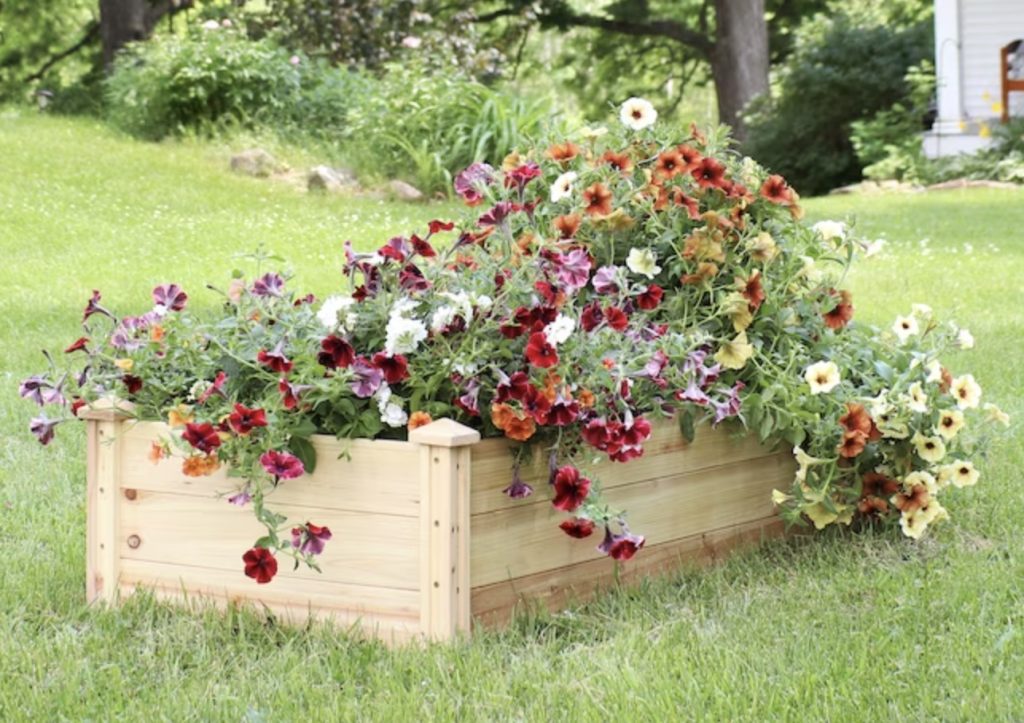

Square Raised Garden Beds
Square raised garden beds are similar to rectangular beds, but they offer a more compact design. They are great for small spaces or for creating a neat and organized garden. Square garden beds also provide easy access to all sides of the bed for planting, maintenance, and harvesting.
Here’s a square one made using cedar that I like from Lowe’s.
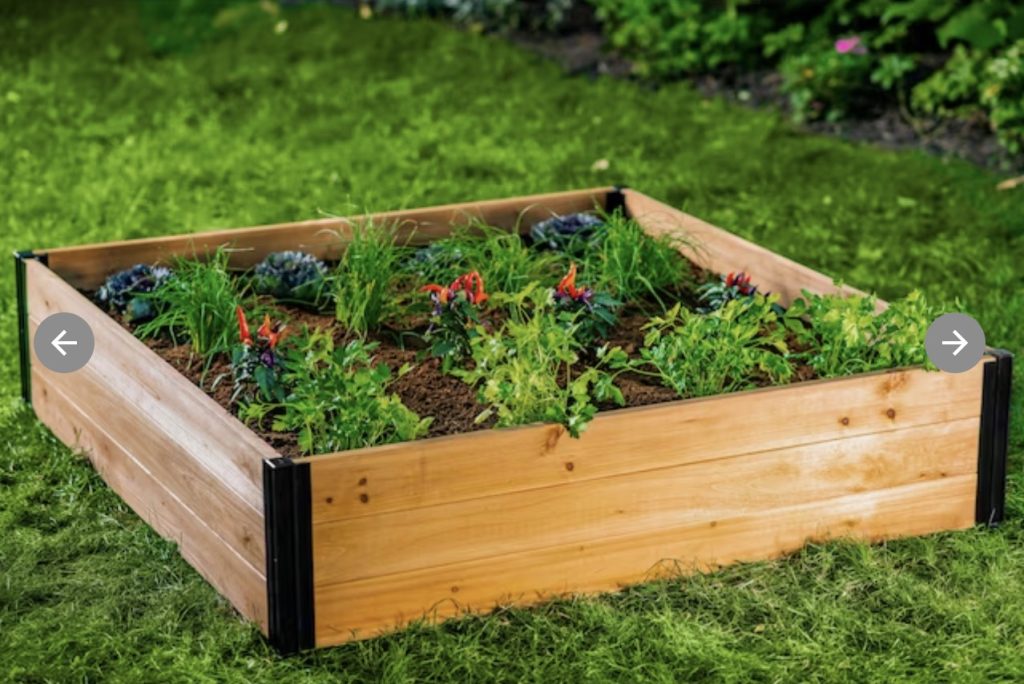
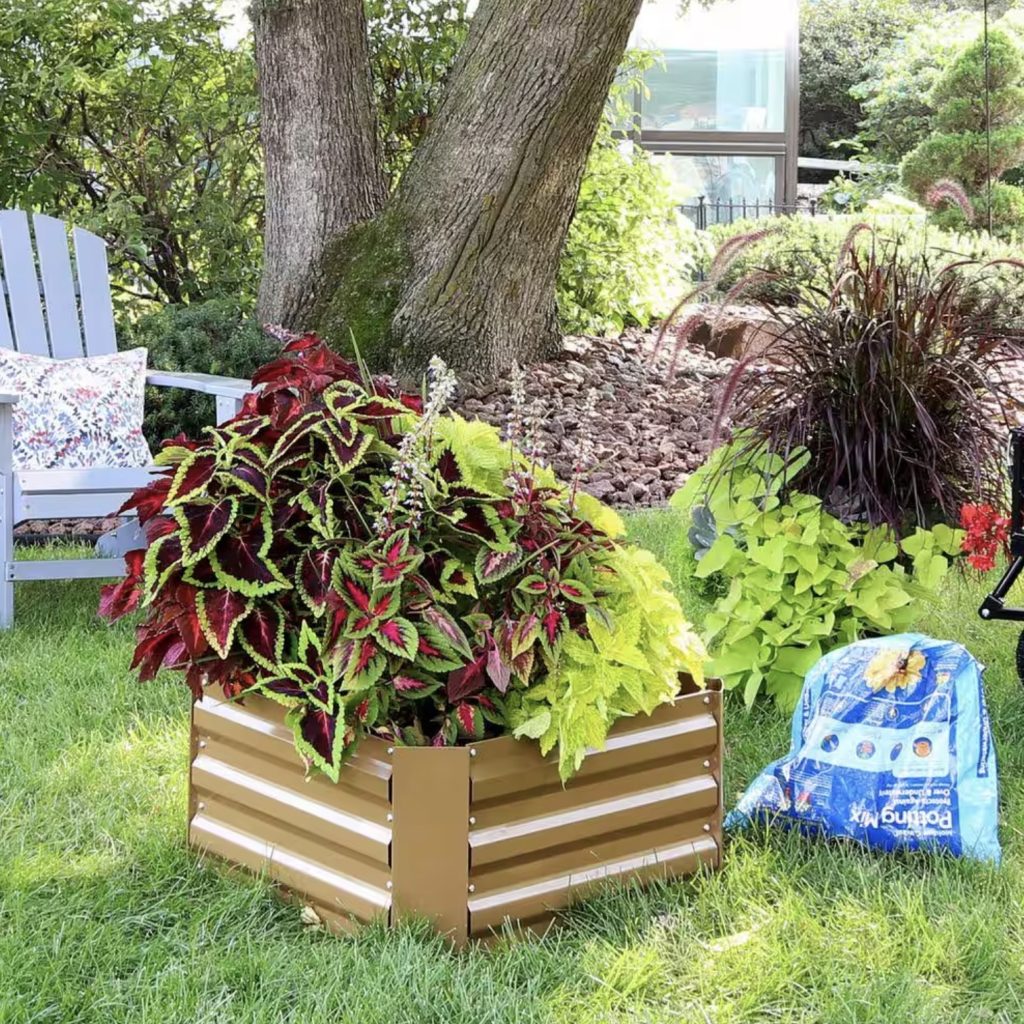
Circular Raised Garden Beds
Circular raised garden beds are a unique and attractive design option that can add visual interest to your garden. They are great for creating a focal point in a garden and can be used for planting flowers, herbs, or vegetables. Circular garden beds can also be designed to fit the size and shape of your garden space.
Check this one out from Lowes – I love the metal!
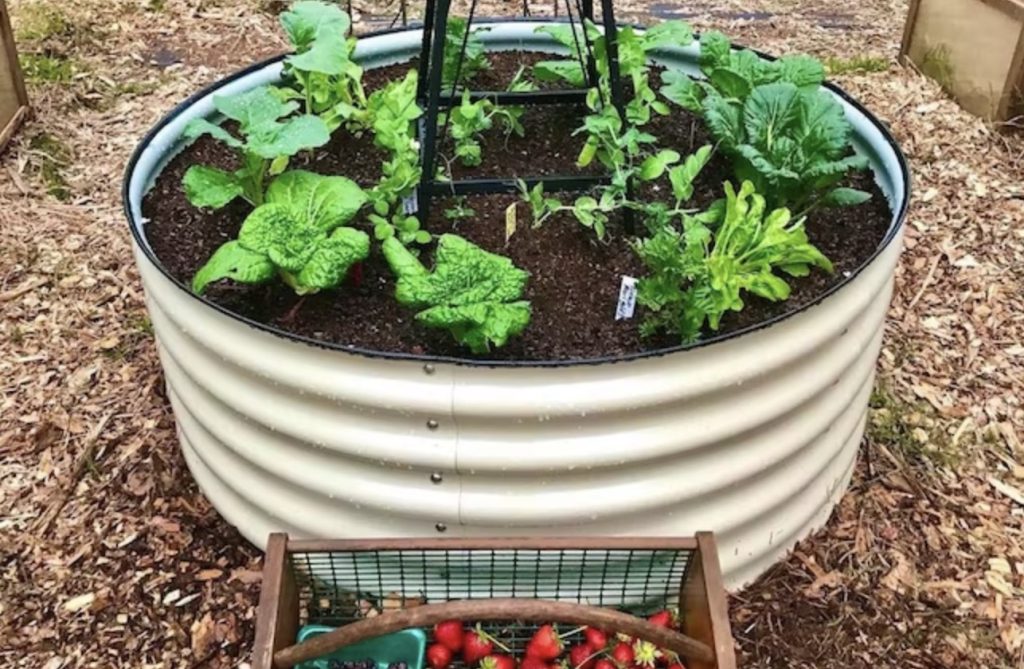

L-Shaped Raised Garden Beds
L-shaped raised garden beds are a great way to maximize space in a corner or along a wall. They are ideal for creating separate planting areas for different types of plants or for creating a designated space for a garden.
To continue on my metal obsession, here’s one I love from Lowe’s
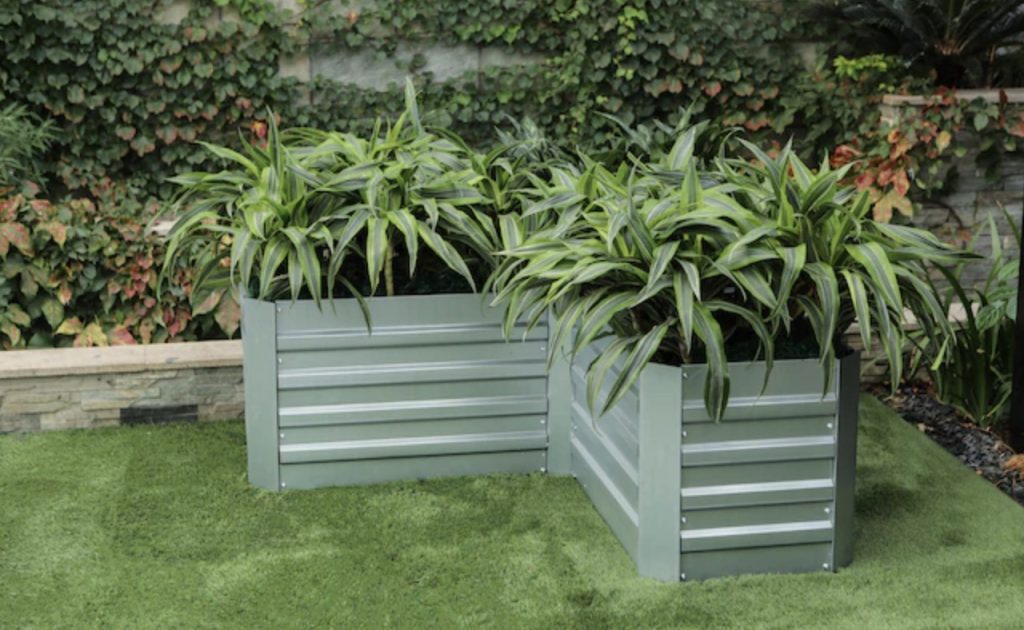
Tiered Raised Garden Beds
Tiered raised garden beds are an excellent option for creating a visually appealing garden with varying heights and depths. They are great for sloped areas or for creating different levels of soil depth for different types of plants.
I’m obsessed with this tiered L-Shaped raised garden bed from Lowe’s – perfect for a back deck!
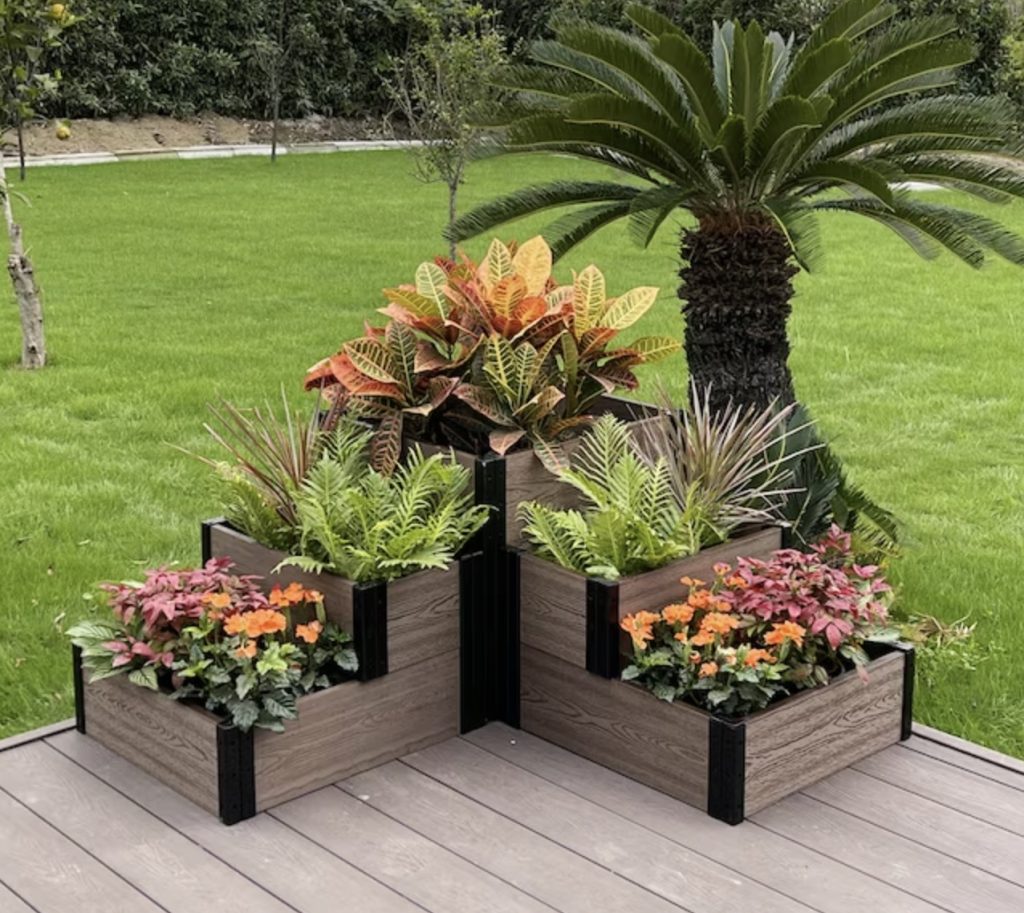
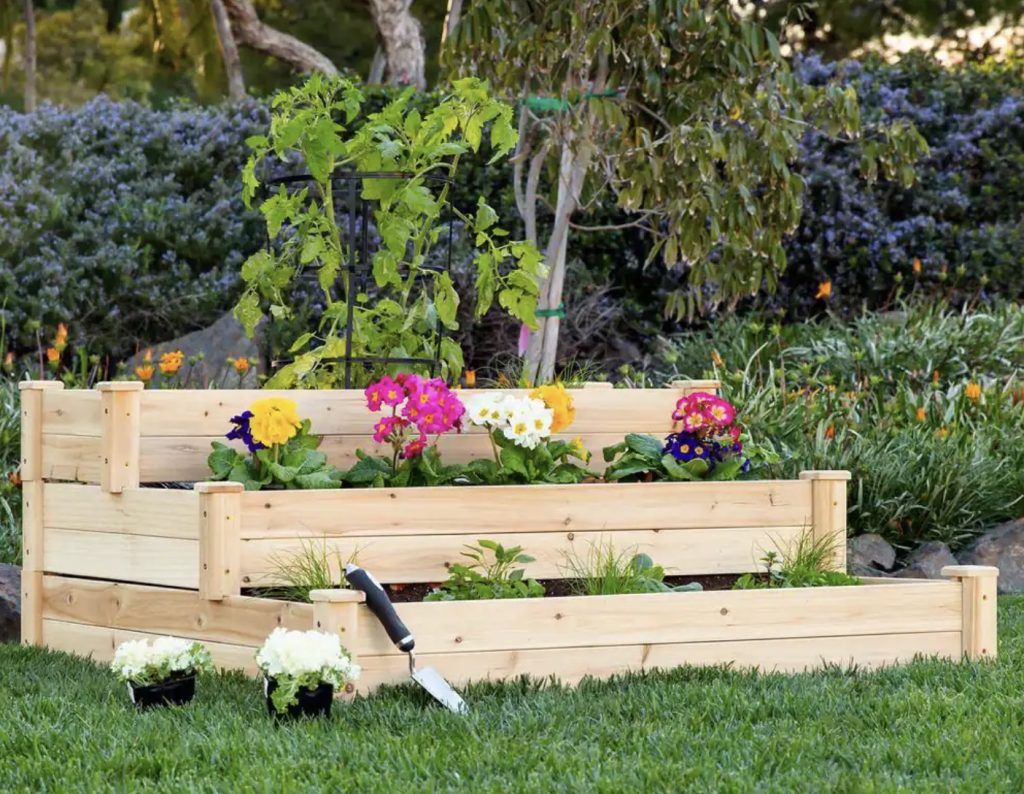
Vertical Raised Garden Beds
Vertical raised garden beds are a great option for small spaces or for creating a garden on a balcony or patio. They can be designed to hang on a wall or be free-standing, and they offer a unique way to grow plants in limited space.
Here’s a beautiful wooden vertical garden planter box idea from Lowe’s.
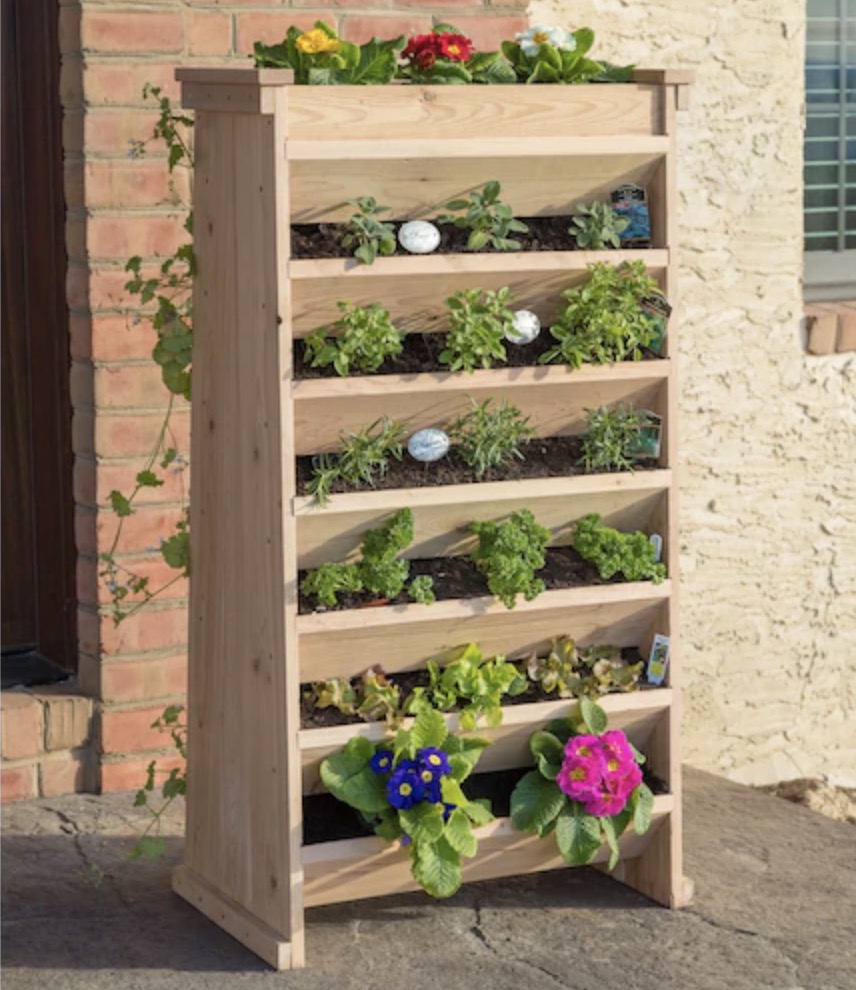
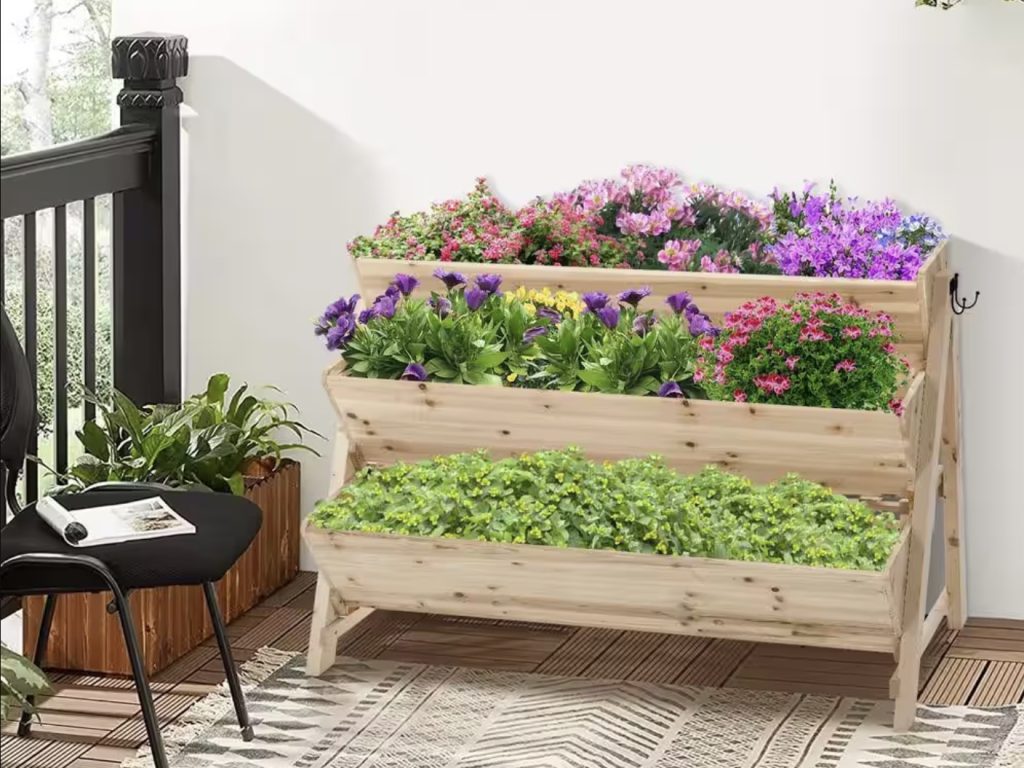
Other Unique Designs for Raised Garden Beds
In addition to the traditional rectangular, square, and circular designs, there are several unique designs for raised garden beds that offer additional benefits for growing plants. Here are some examples of unique raised garden bed designs:
Multi-level raised garden beds
Multi-level raised garden beds offer several levels of planting areas, allowing for a variety of plants to be grown in the same space. They are ideal for growing plants that require different soil depths, such as vegetables, herbs, and flowers. Multi-level garden beds can also provide a unique and visually appealing design element to your garden.
Keyhole gardens
Keyhole gardens are circular raised garden beds with a notch in the middle that provides easy access to the plants. They are called “keyhole” gardens because they resemble a keyhole when viewed from above. Keyhole gardens are great for growing vegetables and herbs and are ideal for small spaces.
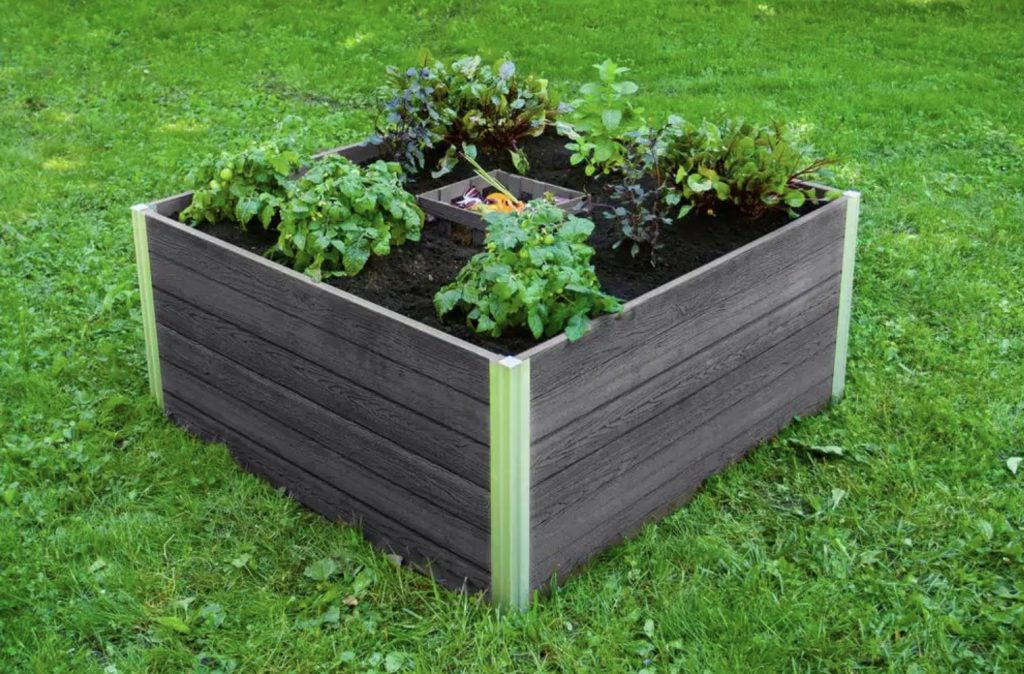
Vertical gardens
Vertical gardens are a unique and space-saving way to grow plants in limited space. They can be designed to hang on a wall or be free-standing, and they offer a creative way to grow plants in urban areas or on balconies and patios. Vertical gardens can be made with a variety of materials, such as pallets, PVC pipes, or gutters.
Wicking beds
Wicking beds are raised garden beds that use a reservoir of water at the bottom of the bed to keep the soil moist. They are ideal for growing plants in dry or arid climates and can help conserve water. Wicking beds are also great for growing vegetables and herbs.
Hugelkultur beds
Hugelkultur beds are raised garden beds that use a technique of layering organic material, such as logs, branches, and leaves, to create a raised bed. The organic material decomposes over time, providing a rich soil for plants to grow in. Hugelkultur beds are ideal for growing vegetables, fruits, and herbs, and can also help conserve water.
Additional Design Ideas for Raised Gardens
Incorporating trellises, arches, and other structures into your raised garden bed design can add a functional and aesthetic element to your garden. Here are some tips for incorporating structures into your raised garden bed design:
Choose the right type of structure
Consider the type of plants you want to grow and choose a structure that is appropriate for their growth habits. For example, if you want to grow climbing vegetables like tomatoes or cucumbers, a trellis or arch would be a good choice.
Consider the size and location of the structure
The size and location of the structure should be appropriate for the size of your garden and the plants you want to grow. A large trellis or arch may overwhelm a small garden, while a small trellis may not be sufficient for tall or heavy plants.
Use structures to create focal points
Structures like trellises, arches, and pergolas can be used to create focal points in your garden. Placing a trellis or arch at the entrance of your garden can create a welcoming focal point and draw the eye into the garden.
Combine structures with plants
When you combine structures with plants, you can create a beautiful and functional garden design. For example, planting climbing plants around a trellis or arch can create a natural and visually appealing design.
Choose materials that match your garden design
The materials you choose for your structures should match the style and design of your garden. Wood, metal, and bamboo are all popular materials for trellises and arches and can be used to create a variety of styles, from rustic to modern.
Consider maintenance requirements
The structures you choose should be easy to maintain and clean. Wooden structures may require regular staining or sealing, while metal structures may need to be treated to prevent rust.
Ideas for Raised Garden Beds
The Benefits of Using Raised Garden Beds
Here’s the deal – raised garden beds have become increasingly popular in recent years, and for good reason. There are a lot of benefits to using raised beds in your garden. Here are just a few:

Raised Garden Beds Improve Soil Quality
With raised garden beds, you have control over the soil you use, which means you can create the perfect growing conditions for your plants. You can amend the soil with compost, manure, and other organic matter, which can lead to healthier plants and bigger harvests.
Raised Garden Beds Provide Great Drainage
Raised beds take advantage of letting gravity do the hard work of using elevation to improve drainage. This is especially beneficial if you have heavy clay soil or a spot in your yard that tends to get waterlogged.
Raised Garden Beds Make Maintenance Easier
Raised garden beds can make gardening a lot easier on your back and knees (the Lord knows I need that!), as they allow you to garden at a more comfortable height. Additionally, because the soil is contained in the bed, you don’t have to worry about weeds and grass creeping in from the surrounding lawn.
Raised Garden Beds Extend the Growing Season
Because raised beds warm up faster in the spring and retain heat better in the fall, they can extend your growing season. This means you can start planting earlier and harvest later than you would be able to with an in-ground garden.
I still consider myself a beginner, but thankfully raised garden beds can be a great option for both novices and experienced gardeners alike. With a little bit of planning and effort, they can help you create a beautiful and bountiful garden that will provide fresh produce for your family all season long.
Materials for Raised Garden Beds
Raised garden beds are a great way to grow plants in limited spaces or areas with poor soil quality. When it comes to constructing a raised garden bed, the choice of material is crucial. There are various types of materials available for constructing a raised garden bed, each with its own advantages and disadvantages.
Here are some of the most popular materials to use for constructing raised garden beds.
Wooden Raised Garden Beds
Wooden raised garden beds are a popular choice among gardeners because they are relatively inexpensive and easy to work with. Wood is readily available and make it easy to create a variety of shapes and sizes for your garden bed. The natural look of wood can also add to the aesthetic appeal of your garden. However, wood is susceptible to rot, and therefore, it requires regular maintenance.
Pro-Tip: To prolong the lifespan of your wooden raised garden bed, it is recommended to use rot-resistant wood such as cedar, redwood, or treated pine.
Personally, I prefer raised garden beds with cedar if you’re going to use wood like the one below.
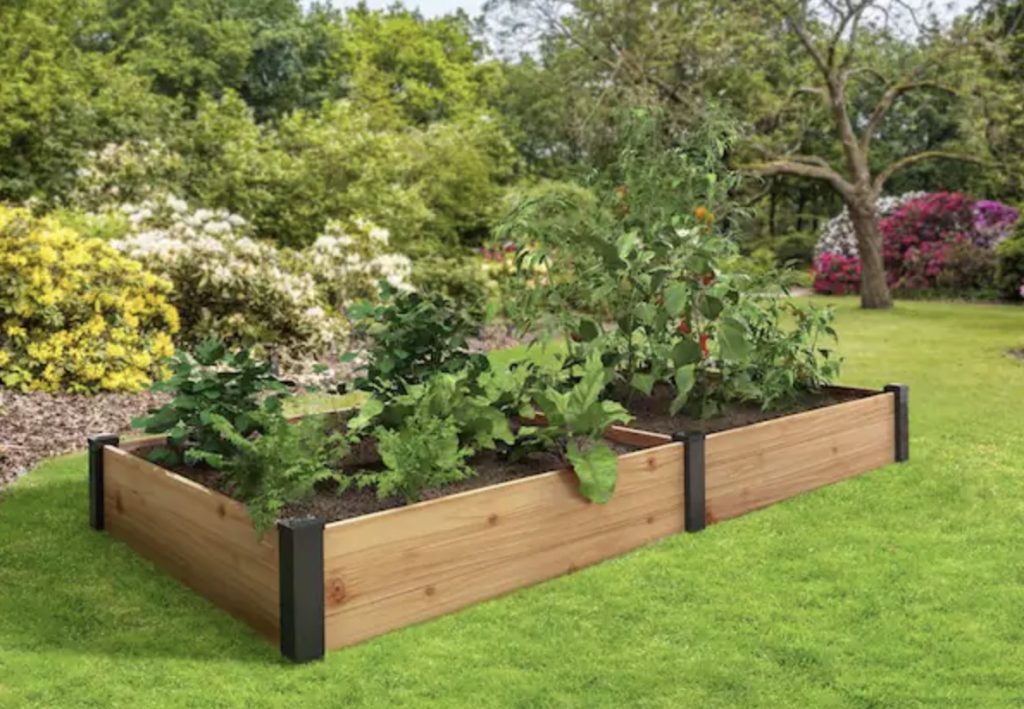
Brick Raised Garden Beds
Bricks are another material you can use for constructing raised garden beds. They are durable and long-lasting, providing a sturdy foundation for your garden bed. Bricks are easy to work with and can be arranged in different patterns to create an attractive design. However, bricks are heavier and harder to move than wood, making them a less flexible option. Additionally, the cost of bricks is often higher when compared to other materials.
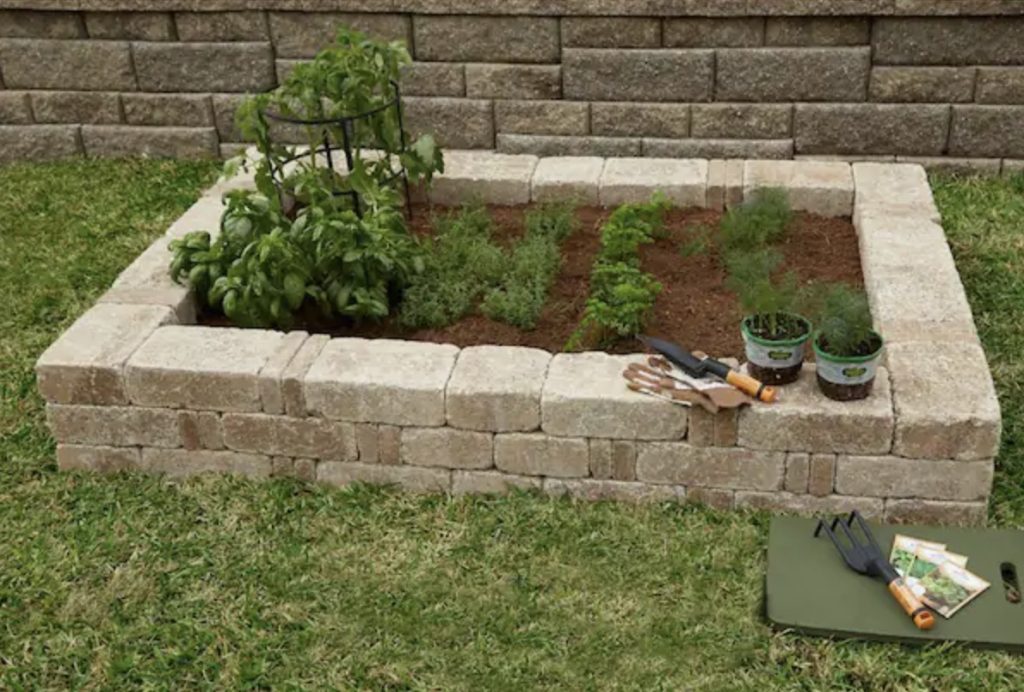
Metal Raised Garden Beds
Metal raised garden beds are becoming increasingly popular because they are long-lasting and require minimal maintenance. They is resistant to rot and pests, making it a low-maintenance option. Metal raised garden beds are also sturdy and can withstand harsh weather conditions. However, metal can get hot in the sun, potentially damaging the plants, and may require additional insulation to prevent this. Metal raised garden beds can also be more expensive than other options, such as wood or concrete blocks.
Concrete Block Raised Garden Beds
Concrete blocks are a durable and affordable material option for constructing raised garden beds. They are easy to work with and require minimal maintenance. Concrete blocks provide a stable foundation for your garden bed and are easy to arrange in various configurations to create an attractive design. However, concrete blocks are heavy, making them challenging to move once they are in place. They may also require additional insulation to prevent them from absorbing too much heat.
Things to Consider when Choosing a Material
Choosing the best material for your raised garden bed depends on your needs, budget, and personal preferences. Here are some tips that can help you make an informed decision when selecting the best material for your raised garden bed:
Consider your budget
Before deciding on a material, determine how much you are willing to spend on your garden bed. The cost of materials varies, and some materials may be more expensive than others. Keep in mind that the cost of materials will depend on the size and design of your garden bed.
Evaluate the durability
Consider how long you want your garden bed to last. Some materials are more durable than others, and the lifespan of your garden bed will depend on the material you choose. If you want a long-lasting garden bed, materials such as brick, metal, and concrete blocks may be a better option than wood.
Think about maintenance
Consider the maintenance requirements of the material you choose. Some materials require more maintenance than others. For example, wood requires regular sealing or staining to prevent rotting, while metal and concrete blocks are low-maintenance options.
Evaluate the aesthetic appeal
Consider the overall look you want to achieve with your garden bed. Some materials, such as wood, provide a natural look that blends in well with the surrounding landscape. Brick and concrete blocks can create a more structured and formal appearance. Metal can provide a modern and sleek look.
Consider your location
The climate and environment of your location can impact the choice of material for your raised garden bed. For example, wood may not be suitable for areas with high humidity or heavy rainfall, as it is prone to rotting. In contrast, metal may not be ideal for hot, sunny areas, as it can get too hot and damage the plants.
Ultimately, the best material for your garden bed is one that provides the desired functionality, durability, and aesthetic appeal for your specific gardening needs.
The choice of material for constructing a raised garden bed largely depends on personal preferences and specific needs. Wooden raised garden beds are inexpensive and easy to work with, but require regular maintenance. Bricks are durable and long-lasting, but can be heavier and more expensive. Metal raised garden beds are low-maintenance and sturdy but can get hot in the sun. Concrete blocks are affordable and durable, but may be challenging to move and require additional insulation. Careful consideration of the pros and cons of each material type will help you make an informed decision when constructing your raised garden bed.
How to Prevent Grass & Weeds From Growing in Your Garden Bed
Using cardboard as a weed barrier is a cost-effective and eco-friendly way to prevent grass and weeds from growing in your raised garden bed. Here are some tips for using cardboard in your garden bed:
Choose biodegradable cardboard
When using cardboard as a weed barrier, it is important to choose biodegradable cardboard that will break down over time. Avoid using glossy or wax-coated cardboard, as these materials may not break down easily and can be harmful to your plants.
Prepare your garden bed
Before laying down the cardboard, make sure your garden bed is free of debris and level. If necessary, add a layer of compost or other organic material to improve soil quality.
Lay down the cardboard
Unroll the cardboard and lay it flat on the ground, covering the entire surface of your garden bed. Overlap the edges of the cardboard to create a seamless barrier.
Wet the cardboard
Once the cardboard is in place, wet it down with a hose or watering can. This will help the cardboard conform to the shape of the garden bed and prevent it from blowing away.
Add soil and mulch
Once the cardboard is wet, add a layer of soil on top of it. You can also add a layer of mulch to help retain moisture and prevent weeds from growing. Plant your desired plants as usual.
Monitor the cardboard
Over time, the cardboard will begin to break down and decompose. This process can take several months to a year, depending on the thickness of the cardboard and the climate. As the cardboard breaks down, it will add organic matter to your garden bed, improving soil quality.
Here’s Raised garden idea from a project I did recently: Container Gardening
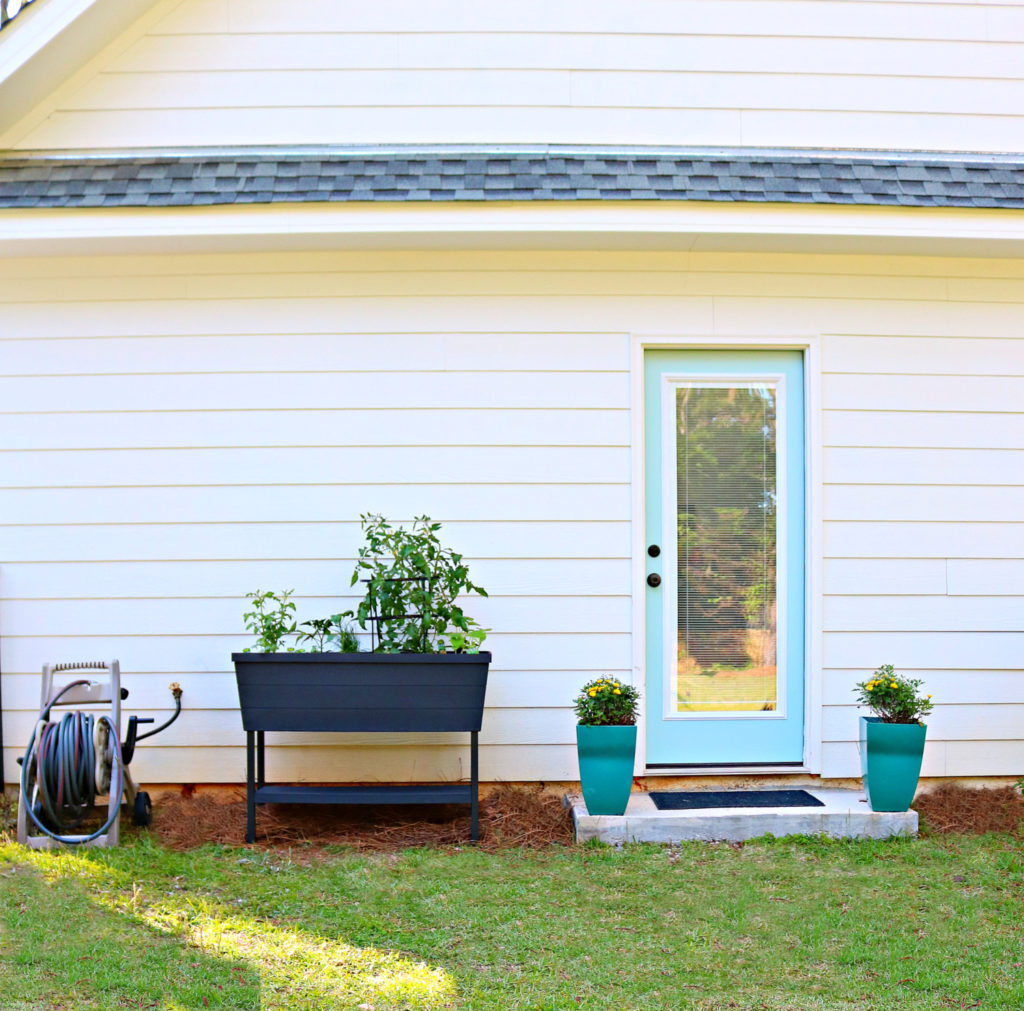
A goal of mine for several years has been to create a raised garden. I have a spot picked out, it gets plenty of sun and would not be an eye-sore in the back yard.
I could deter small critters with a cute DIY fence.
There will be herbs and tomatoes. I’d check this growing calendar to make sure my timing is right.
We could build another bench to sit and watch our garden grow…
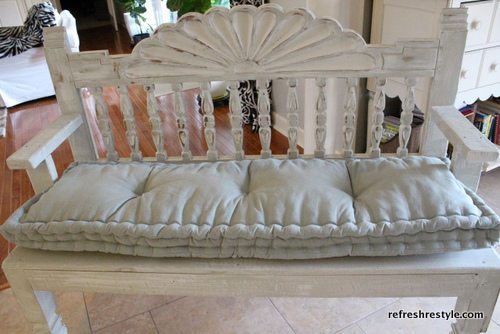
Do you have any weekend projects planned?

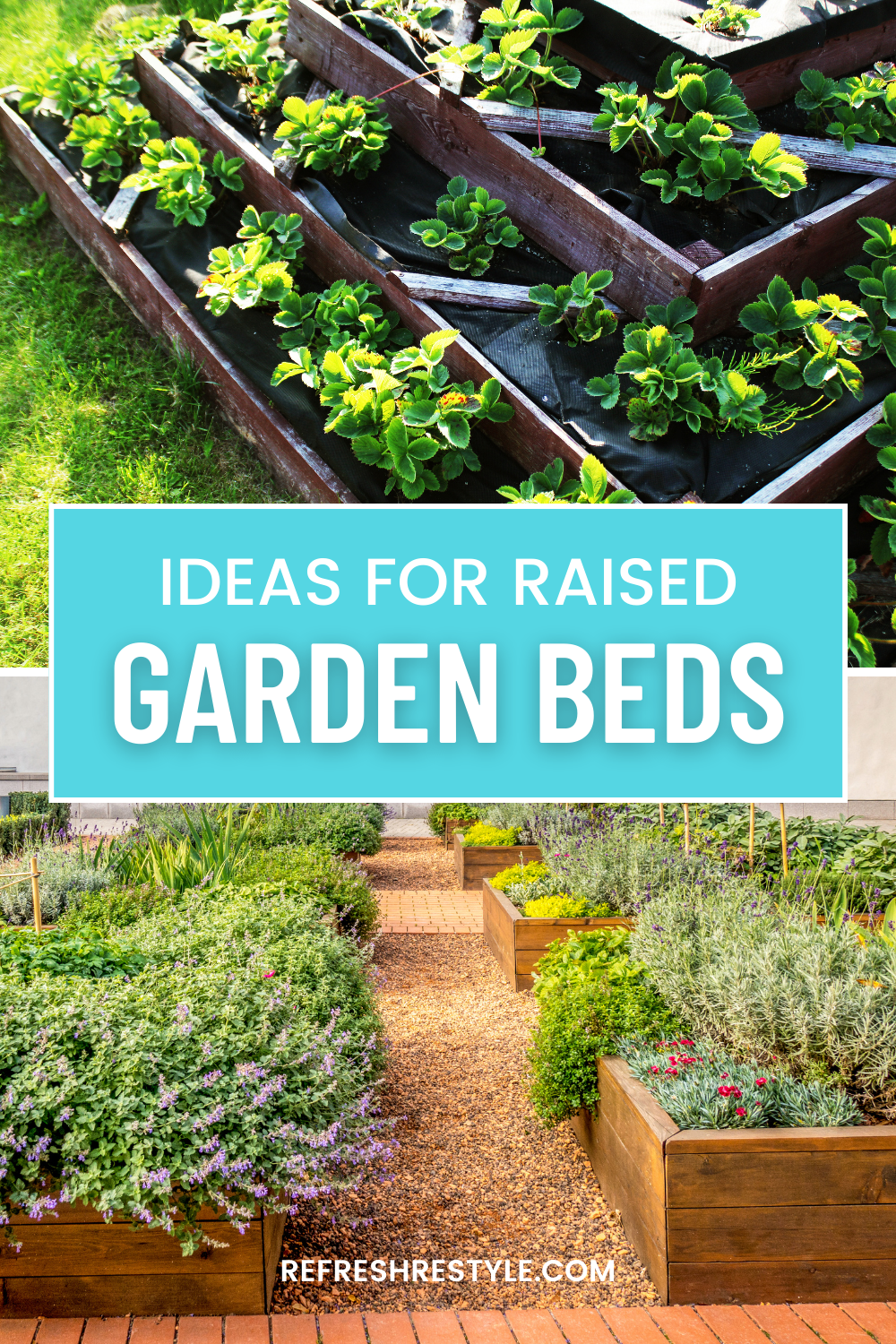
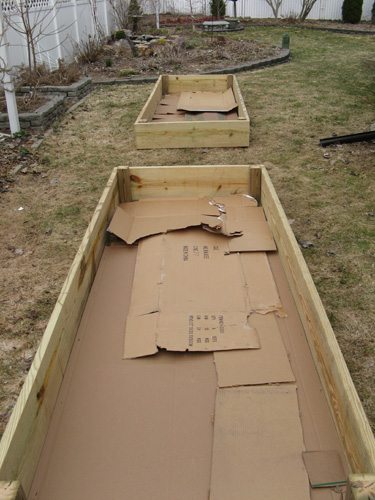





Love the raised bed approach! Curious about how you access the bed with the fence all around it?
They lift off Judy if you need to get closer than just reaching over.
Thanks!
Hi Debbie! I would love a raised garden and our new home does have room for one.
I look forward to seeing what you grow.
xx,
Sherry
We just finished our weekend project – here:
Thoughts From Crow Cottage
A simple job but one we never have tried, installing a ceiling light fixture.
Now those raised bed are looking very good indeed… I’m thinking of deck pots for plants this year.
We have a raised garden in the side yard–unfortunately the critters are into it on a regular basis.
Best of all I like the bench. Basil is wonderful to have around, enjoy your adventure.
We built one box two years ago and hubby needs to build a couple more. I told him it is time to get going.
This has been my goal every year for the past 30 years. But my husband always tries another “method” and needless to say if he would just listen to me and do my bidding a raised bed garden would be in our yard this year. I did pick up seeds……
Oh I need to start one of those too! Thanks for the inspiration!